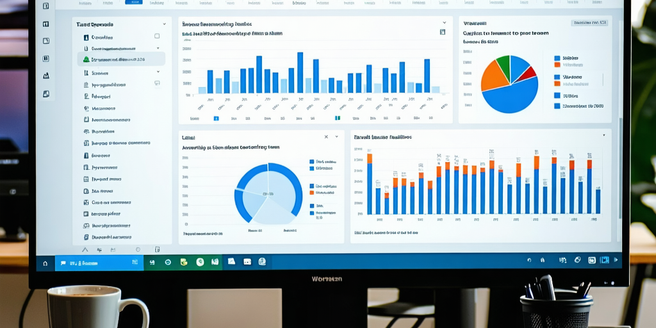Sweepstakes Analytics And Tracking

Understanding Sweepstakes Analytics Basics
| Metric | Description | Importance |
| Entries Count | Total number of participants | High |
| Conversion Rate | Percentage of participants taking action | Medium |
| Engagement Duration | Time spent on the campaign | Low |
| Demographics | Information about participants | High |
| Referral Sources | Channels driving entries | Medium |
| Prize Distribution | Analysis of prize allocation | Low |
Key Metrics to Track Sweepstakes Performance
Tracking the performance of a sweepstake is crucial to ascertain its success. Key metrics include the number of entries, conversion rates, and engagement duration. Regular analysis of these key indicators allows for timely interventions and strategic improvements. Analyzing these metrics can also help predict future trends and opportunities for growth. A well-monitored sweepstake can provide valuable insights into consumer behavior and preferences. Entries highlight the reach and popularity among the target audience. Conversion rates shed light on the effectiveness of the sweepstake in prompting desired actions. Engagement duration helps gauge participant interest and overall engagement levels. By monitoring these metrics, marketers can identify the strengths and weaknesses of their sweepstake initiatives, making adjustments where necessary to optimize future campaigns and enhance their impact.
Tools for Sweepstakes Data Collection
In the realm of sweepstakes, data collection tools are indispensable for gaining insights into participant behavior and campaign effectiveness. Various analytical tools, such as Google Analytics and specialized sweepstakes platforms, provide metrics on user engagement, traffic sources, and conversion tracking. With the right data, marketers can pinpoint exactly what elements of a campaign generate the most interest and excitement. These insights are crucial for understanding what resonates with the audience. These tools offer a comprehensive view of how participants interact with the campaign, facilitating refined strategies tailored to audience preferences. By leveraging data collection tools, marketers can enhance decision-making processes, ensuring every sweepstake is data-driven and poised for optimal success and engagement.
Analyzing Participant Demographics
Understanding the demographics of participants is essential in crafting targeted and effective sweepstakes. By analyzing age, gender, location, and interests of entrants, marketers can tailor their campaigns to better resonate with their audience. Moreover, leveraging this information enables companies to stay competitive in an ever-evolving market. Additionally, this process can reveal trends that inform future marketing strategies. With precise demographic data, they can predict participant preferences more accurately. These insights help in creating personalized experiences, increasing engagement, and optimizing resource allocation. Additionally, understanding cultural and socioeconomic factors can further refine targeting strategies. Demographic analysis also aids in identifying untapped segments, providing opportunities to expand reach. Ultimately, a thorough demographic analysis ensures a strategic approach to sweepstakes, enhancing relevance and appeal among the intended audience.
Interpreting Engagement Trends
Identifying and understanding engagement trends is crucial for the sustained success of sweepstakes events. By monitoring when and how participants interact with campaigns, marketers can pinpoint peak engagement periods and preferred participation methods. Analyzing these trends allows for strategic adjustments in timing and content delivery, maximizing participant interest. Effective analysis can also reveal emerging trends that might influence future campaign planning. Incorporating feedback from participants can also provide valuable insights into improving future campaigns. Consistent tracking of metrics is essential to accurately assess these engagement patterns. Recognizing patterns in engagement also contributes to predicting future actions, enabling more effective and proactive campaign planning. Ultimately, interpreting engagement trends facilitates a deeper connection with the audience, driving enhanced participation and sweepstakes success.
Effective Tracking of Entry Methods
Efficiency in tracking entry methods is pivotal for understanding which channels perform best in driving participation. Whether through social media, email, or direct website entries, gathering this data enables marketers to optimize their approach and focus efforts on the most effective platforms. Marketers constantly seek innovative tools to streamline this process. By implementing AI-driven software, they can automate data collection, reducing the risk of human error. Utilizing real-time analytics can provide marketers with immediate feedback on their current strategies. Employing UTM codes and referral tracking further clarifies the journey of each participant, offering insight into acquisition methods. This data-informed strategy ensures resource investment aligns with participant preferences, thereby bolstering entry rates and ultimately enhancing the impact and success of sweepstakes campaigns.
Assessing the ROI of Sweepstakes
Evaluating the return on investment (ROI) of a sweepstake is vital to ascertain its value and success. It is important not only to look at immediate gains but also to consider long-term benefits. Understanding these aspects helps businesses plan more effectively for future campaigns. ROI is derived by comparing the campaign costs against the benefits gained, such as increased sales, brand awareness, or new leads. Analyzing ROI helps in understanding the financial efficacy of the sweepstake, guiding future budget allocations and strategic planning. Regular ROI assessments provide deeper insights into consumer behavior and campaign impact. Effective ROI measurement ensures that the sweepstake delivers significant value, enabling informed decision-making and highlighting areas for improvement to maximize profitability and audience engagement.
Overcoming Common Analytics Challenges
Marketers often face challenges in sweepstakes analytics, such as data integration, accuracy, and participant tracking. Data silos can hinder comprehensive insights, while inaccurate data skews analysis and decision-making. Implementing best practices in data management not only addresses these issues but also boosts overall marketing efficiency. Continuous training and development in data management are essential to adapt to evolving analytics tools. Overcoming these hurdles involves utilizing unified platforms and ensuring data accuracy through regular audits and validation processes. Additionally, leveraging technologies that offer real-time tracking and insights can bridge gaps, providing a complete picture of sweepstake performance. By addressing these common challenges, marketers can enhance their campaign analysis, optimizing strategies for improved outcomes and participant engagement.
Best Practices for Data Visualization
In sweepstakes analytics, effective data visualization is crucial for communicating insights and driving strategic action. Using intuitive charts, graphs, and dashboards makes it easier to comprehend complex data at a glance. It’s important to remember that clarity and simplicity should always be prioritized for maximum impact. Additionally, consistent use of color and labeling enhances the interpretability of visualizations. Key practices include selecting the appropriate visualization type for the data, maintaining simplicity, and emphasizing significant trends or outliers. By presenting data clearly, stakeholders can swiftly identify areas of success and those requiring attention, facilitating data-driven decisions. Employing best visualization practices ensures insights are accessible and actionable, enhancing the overall effectiveness of sweepstakes analysis.
Leveraging Insights for Future Campaigns
Gleaning insights from past sweepstakes is integral for the refinement and success of future campaigns. Analyzing metrics such as entry methods, participant demographics, and engagement trends informs strategic decisions. These insights aid in tailoring upcoming campaigns to better meet participant preferences and expectations, enhancing engagement and conversion rates. Moreover, keeping an eye on industry trends can provide additional context for the data. Additionally, understanding seasonal variations and external factors can significantly influence campaign outcomes. Reflecting on past successes and shortcomings allows marketers to continuously refine strategies, ensuring each new initiative surpasses the last in efficiency and impact. By incorporating feedback from participants, marketers can make even more informed adjustments. Leveraging these insights guarantees ongoing improvement and sustained success in sweepstakes campaigns.
